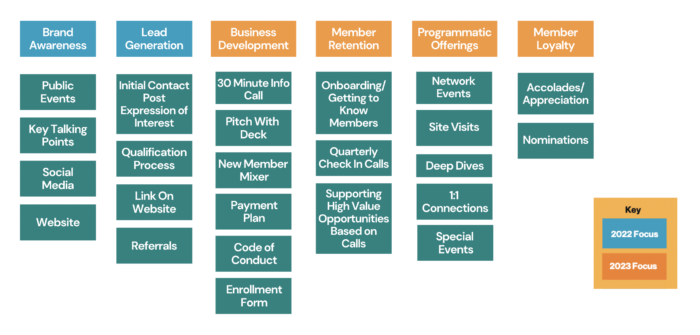The death of George Floyd, and the subsequent heightened awareness of racial inequities, created urgency for companies to understand how they can diversify their stakeholders. Many leaders have echoed the same sentiment: “We really do want to do our part to shift our practices and make sure we have more diversity, but we are frustrated because we have been unsuccessful in attracting that diversity.”
At H3Diversity, we work with employers to reduce biases in the recruitment process for both future employees and key stakeholders. To help you get a head start on diversifying your hiring process, here are the 3 bias reduction tips that our clients have found most useful:
Head: Use a process map to identify the biggest areas of impact in your recruitment process.

First, outline each step in the process. Then prioritize interventions by targeting areas where decisions are made. Note that decision points are where biases most often creep in.
This process map was created for a company that is working to diversify its network by increasing the representation of BIPOC and women in membership. The map helped us make choices about where to focus the client’s resources by creating a three-year plan. We established that the best place for them to start diversifying their membership is at the very beginning of their pipeline, with brand awareness, which will ultimately increase lead generation. Key priorities include shifting their social media spend to a more targeted outreach, and hosting informational events in communities that include their targeted populations.
Heart: Incentivize and reward employees for relationship building.
Another client, a startup organization that has grown quickly since its inception in 2020, is working to increase the diversity of its client base. We conducted qualitative interviews to understand what might be preventing this organization from recruiting and retaining a more diverse clientele. We learned that a key barrier was lack of relationships in communities of color, which made the recruitment process seem insincere.
Relationship building and brand awareness take time. We are observing that in urgent attempts to focus on delivering outcomes in diversity, organizations are not investing the time and resources necessary to build relationships with and understand the nuances of the populations they are targeting. This dynamic is particularly prevalent when working to diversify brands’ internal customer population: employees. We recommend that organizations prioritize intimacy with both external and internal customers by immersing themselves in the communities they are seeking to target, and rewarding employees for investing time and money in forming these connections through physical events such as focus groups, house meetings, and recruitment fairs, or online through social media. It is these connections, and the understandings that arise from them, that will ultimately enable your organization to create brand positioning, messaging, and value propositions that open the hearts and minds of your targeted communities.
Hands: When developing job descriptions, keep asking “Why?” until you get to the core skills and values you are seeking.
Oftentimes when creating job descriptions, the picture in our mind of the type of candidate who might be a good fit for the role is based on our own previous experiences. That’s natural and human. One person shared that he thought someone who had been a teacher might be a good fit for a job he was posting. He knew that he was biased because he had been a teacher himself, however, a bias can support direction if approached with curiosity. When you notice a bias, make it a practice to ask yourself, “Why?”
Here’s an example: “I think a teacher would be good for this role.” Why? “Teachers are great at presenting.” Why? “Teachers can break down complex ideas in simple ways that everyone can understand.” Great! What you are really looking for is “someone who is able to communicate complex ideas in simple ways.” Include that in the job description.
As we work toward creating more diversity in our organizations, the key is to remember that all of us have biases. These biases are part of the reason that actively working toward diversity takes time, effort, and resources. Manifesting our values of diversity and inclusion comes at a cost, however, commitment to these values, and allowing ourselves room to fail forward, will yield the innovation necessary to create the solutions that we seek.
Looking for a team to help diversify your organization? Contact H3Diversity here.



